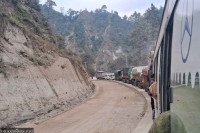Editorial
Ideate before implementing
Authorities must first weigh the utility, functionality and safety of the national ID before imposing it.
In June, when the Cabinet decided to make National Identity Card (NID) mandatory for accessing government services, including social security allowances, it was widely criticised, with even federal lawmakers voicing their disapproval. The Home Ministry had announced that the directive would be enforced in 28 districts, setting a deadline of mid-July. This decision had “terrorised people”, as they feared they would be deprived of social security services, and many registered in haste.
But the government last month decided to overturn the directive with equal haste. Now, the Nepalis are left confused: To obtain it or not to obtain it? Seemingly disbelieving the government's changing position on the use of the NID, over half a million people opted for it between mid-June to mid-July. Yet, there is little information about whether the government has worked out the behind-the-scenes procedures for its proper utility.
Despite the NID’s design to combine important identity cards and documents including driving licenses, academic documents, voting cards, insurance details, and ATM card numbers in a single chip, implementing agencies still lack the infrastructure for such an endeavour. This technological hurdle adds to the already challenging task of fully executing the NID card campaign six years after the government started distributing it. Moreover, the hubbub surrounding the NID’s “revolutionary” function has proven to be dubious—it is either of no use or is imposed arbitrarily on the people. This is a prime example of how our authorities care not to think about its citizens' comfort or welfare when they come up with new policies or schemes.
The authorities' main argument for implementing the NID is that it will be a one-stop solution for surveilling and controlling criminal activities like financial fraud by removing duplication. Article 51 of the Constitution of Nepal 2015 pledges to develop an integrated national identity management information system and manage citizens' data. The NID and Registration Act 2020 states that personal privacy would be ensured in its usage. But experts believe the document has several loopholes as it does not discuss data protection. Sensitive data and information of the citizens are the nation's assets, and they must be safeguarded diligently. However, the government is yet to fully assure citizens about data privacy; what is working in the government’s favour is that many lack digital literacy enough to know about their privacy rights.
Moreover, the government has not clearly explained how it plans to segregate information access by multiple agencies, as the NID provides an integrated database of different information. This paints a murky picture of Nepal’s cyber security ecosystem, as data security is fragile, and hackers often target government websites. Ever since the launch of the Adhaar Card in India, there have been numerous cases of duping, misuse and information leak. The government must learn from the mistakes of its next-door neighbour before launching a “grand” campaign to digitalise identification.
The government would do well to return to the basics before taking any further steps and clearly address the concerns of experts, lawmakers and citizens about why and how the card is an important addition to other identifications like citizenship, driving license, and passport. Moreover, the authorities should first ideate on the utility, functionality and safety of the NID before imposing it on the citizens.




 16.57°C Kathmandu
16.57°C Kathmandu














